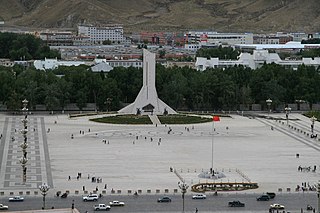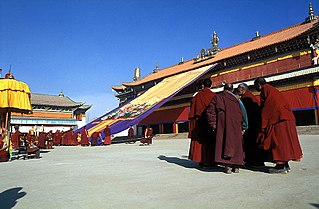The term self-immolation broadly refers to acts of altruistic suicide, otherwise the giving up of one's body in an act of sacrifice. However, it most often refers specifically to autocremation, the act of sacrificing oneself by setting oneself on fire and burning to death. It is typically used for political or religious reasons, often as a form of non-violent protest or in acts of martyrdom. It has a centuries-long recognition as the most extreme form of protest possible by humankind.

Lobsang Trinley Lhündrub Chökyi Gyaltsen was the tenth Panchen Lama, officially the 10th Panchen Erdeni, of the Gelug school of Tibetan Buddhism. According to Tibetan Buddhism, Panchen Lamas are living emanations of the buddha Amitabha. He was often referred to simply as Choekyi Gyaltsen.
Free Tibet (FT) is a non-profit, non-governmental organisation, founded in 1987 and based in London, England. According to their mission statement, Free Tibet advocates for "a free Tibet in which Tibetans are able to determine their own future and the human rights of all are respected."

Kyabje Khenchen Jigme Phuntsok,, was a Nyingma lama and Terton from Sertha Region. His family were Tibetan nomads. At the age of five he was recognized "as a reincarnation of Lerab Lingpa. Known also as Nyala Sogyel and Terton Sogyel, Lerab Lingpa was an eclectic and highly influential tantric visionary from the eastern Tibetan area of Nyarong ." He studied Dzogchen at Nubzor Monastery, received novice ordination at 14, and full ordination at 22. In 1980, he founded Larung Gar, the largest Tibetan Buddhist monastic academy.


In 1980, Kyabje Khenchen Jigme Phuntsok founded Larung Gar, which was officially named by the 10th Panchen Lama in 1987 as Serta Larung Five Science Buddhist Academy, also known of in Tibetan: བླ་རུང་ལྔ་རིག་ནང་བསྟན་སློབ་གླིང་།, ZYPY: Serta Larung Ngarig Nangdän Lobling,, located in the Larung Valley (喇荣沟) near the township of Larung in Sêrtar County, Garzê Prefecture, Sichuan Province, known of as Kham. The Serta Larung Five Science Buddhist Academy grew from Khenchen Jigme Phuntsok's mountain retreat. The purpose of Larung Gar's Academy is to provide an ecumenical training in Tibetan Buddhism and to meet the need for renewal of meditation, ethics, and scholarship all over Tibet in the wake of China's Cultural Revolution of 1966-76.

Ngawa Tibetan and Qiang Autonomous Prefecture, also known as Aba, is an autonomous prefecture of northwestern Sichuan, bordering Gansu to the north and northeast and Qinghai to the northwest. Its seat is in Barkam, and it has an area of 83,201 km2 (32,124 sq mi). The population was 919,987 in late 2013.

Tsering Woeser is a Tibetan writer, activist, blogger, poet and essayist.

The 2008 Tibetan unrest, also referred to as the 2008 Tibetan uprising in Tibetan media, was a series of protests and demonstrations over the Chinese government's treatment and persecution of Tibetans. Protests in Lhasa, the capital of Tibet, by monks and nuns on 10 March have been viewed as the start of the demonstrations. Numerous peaceful protests and demonstrations were held to commemorate the 49th anniversary of the 1959 Tibetan Uprising Day, when the 14th Dalai Lama escaped from Tibet. The protests and demonstrations spread spontaneously to a number of monasteries and throughout the Tibetan plateau, including into counties located outside the designated Tibet Autonomous Region. The arrest of monks at Labrang Monastery increased the tension of the situation. Violence began when Chinese police and People's Liberation Army units used force on non-violent protests by monks and nuns, and spread when protesting Tibetans later clashed with security forces. Clashes also occurred between Tibetans and Chinese Han and Hui residents, resulting in Han and Hui stores and buildings being destroyed and numerous Chinese civilians being injured or killed.

The sinicization of Tibet includes the programs and laws of the Chinese government and the Chinese Communist Party (CCP) to force cultural assimilation in Tibetan areas of China, including the Tibet Autonomous Region and surrounding Tibetan-designated autonomous areas. The efforts are undertaken by China in order to remake Tibetan culture into mainstream Chinese culture.

Ngawa County, or Aba or Ngaba, is a county in the northwest of Sichuan Province, China. It is under the administration of the Ngawa Tibetan and Qiang Autonomous Prefecture. It is located in the remote northwestern part of the prefecture, on the border with Qinghai and Gansu. The county seat is Ngawa Town.

Sêrtar County or Serthar County is a county in the northwest of Sichuan Province, China, bordering Qinghai province to the north. It is one of the 18 counties under the administration of the Garzê Tibetan Autonomous Prefecture, covering some 9,340 square kilometres. Sêrtar, which means "golden freedom" in Tibetan, lies in the southeast of the Tibetan Plateau and in the historical region of Kham. The vast majority of the population is Tibetan, followed by Han Chinese.

Yarchen Gar, officially known as "Yaqên Orgyän Temple", is a Tibetan Buddhist monastery of the Nyingma school, with an educational institute and residential community in western Sichuan, China. The majority of its Tibetan and Chinese residents are nuns, leading to it being called the "City of Nuns". By the end of 2019, more than half of their residences had been demolished by Chinese authorities.

The Phuntsog self-immolation incident occurred when a Tibetan Buddhist monk by the name of Rigzin Phuntsog self-immolated on March 16, 2011 in Ngawa County, Ngawa Tibetan and Qiang Autonomous Prefecture, Sichuan province, People's Republic of China. This was followed by another self-immolation incident on September 26, 2011. By March 2012, more than thirty other Tibetans had self-immolated as a protest against Chinese rule of Tibet.

Kirti Gompa, is a Tibetan Buddhist monastery founded in 1472 and located in Ngawa, Sichuan province, in China, but traditionally part of Amdo region. Numerous other associated Kirti monasteries and nunneries are located nearby. As of March 2011, the Kirti Gompa was said to house 2,500 monks. Between 2008 and 2011, mass arrests and patriotic re-education programs by Chinese authorities have targeted the monks, reducing the population substantially to 600 monks. The wave of Tibetan self-immolations began at Kirti Gompa.

Protests and uprisings in Tibet against the government of the People's Republic of China have occurred since 1950, and include the 1959 uprising, the 2008 uprising, and the subsequent self-immolation protests.

As of May 2022, 160 monks, nuns, and ordinary people have self-immolated in Tibet since 27 February 2009, when Tapey, a young monk from Kirti Monastery, set himself on fire in the marketplace in Ngawa City, Ngawa County, Sichuan. According to the International Campaign for Tibet (ICT), "Chinese police have beaten, shot, isolated, and disappeared self-immolators who survived."

Chen Quanguo is a Chinese retired politician who was the Chinese Communist Party Committee Secretary of Tibet Autonomous Region from 2011 to 2016 and of the Xinjiang Uyghur Autonomous Region from 2016 to 2021, making him the only person to serve as the Party Secretary for both autonomous regions. Between 2017 and 2022, he was a member of the 19th Politburo of the Chinese Communist Party and was also Political Commissar of the Xinjiang Production and Construction Corps concurrently with his position as Xinjiang Party Secretary.

Antireligious campaigns of the Chinese Communist Party are a series of policies and practices, including the promotion of state atheism, coupled with its persecution of people with spiritual or religious beliefs, in the People's Republic of China. Antireligious campaigns were launched in 1949, after the Chinese Communist Revolution, and they continue to be waged against Buddhists, Christians, Muslims, and members of other religious communities in the 21st century. State campaigns against religion have escalated since Xi Jinping became General Secretary of the Chinese Communist Party on November 15, 2012. For Christians, government decrees have mandated the widespread removal of crosses from churches, and in some cases, they have also mandated the destruction of houses of worship, such as the Catholic Three Rivers Church in the city of Wenzhou. In Tibet, similar decrees have mandated the destruction of Tibetan Buddhist monastic centers, the destruction of sacred Buddhist sites, the destruction of monastic residences, the denial of the Tibetan people's right to freely access their cultural heritage, the ongoing persecution of high Buddhist lamas, and the ongoing persecution of Buddhist nuns and monks. Reports which document the existence of forced re-education camps, arrests, beatings, rape, and the destruction of religious sites in Tibet are also being published with regard to the Uyghur people, who are being subjected to an ongoing genocide.

















